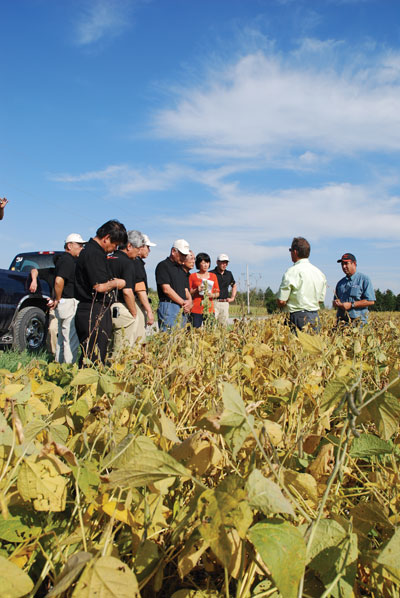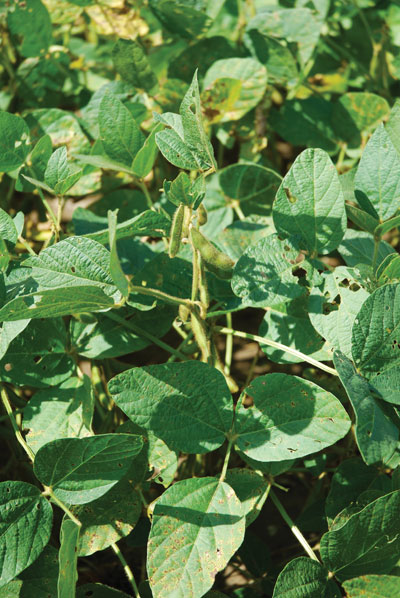
News
Soybean growth in Atlantic Canada
Until recently, areas of Canada outside of southwestern Ontario have been at a disadvantage for soybean production because of their cooler climate and a dearth of soybean varieties suitable for low heat units.
December 22, 2008 By Heather Hager
New markets and better prices may encourage growers to plant soybean.
Until recently, areas of Canada outside of southwestern Ontario have been at a disadvantage for soybean production because of their cooler climate and a dearth of soybean varieties suitable for low heat units. However, good-yielding varieties have become available in the last 10 years, and particularly in the last five years, says Mike Price, field crops specialist with the New Brunswick Department
 |
|
| Attracting buyers from Japan has been just one facet of the Maritime soybean industry, with interest also coming from organic and livestock feed sectors. Advertisement
|
of Agriculture and Aquaculture. If soybean prices remain strong, as they have been since late 2006, soybean could catch on as a valuable cash crop in Atlantic Canada.Agricultural census data from Statistics Canada indicate that between 1996 and 2006, the acreage of soybean in Prince Edward Island and Nova Scotia approximately doubled, and that in New Brunswick it increased by about one-third. “We don’t grow a lot of soybeans in New Brunswick,” says Price. Since 2006, New Brunswick’s soybean acreage has remained at about 2000 acres. Soybean is not grown in Newfoundland.
In Nova Scotia, the acreage has increased to between 4000 and 5000 acres, says AgraPoint agronomist Jack van Roestel. By contrast, soybean acreage on Prince Edward Island has increased from a base level of about 7000 acres between 2000 and 2005 to about 18,000 acres in 2008, one-third of which is food-grade production, says Will Proctor, crop innovation officer with the PEI Department of Agriculture. These differences in acreage are related to market opportunities and challenges associated with adding or switching to a new crop.
From feed to cash crop
Since about 1976, soybean has been produced on hog or dairy farms and used for livestock feed. According to van Roestel, 80 percent of soybean in Nova Scotia is still grown and used on the farm for dairy production. The soybean is only sent off the farm for roasting, except on the largest dairy operations, which often have their own roasting facilities. However, the acreage grown as a cash crop has increased. “I’d say up until a couple of years ago, less than five percent of our acreage was for cash crop. Now it’s in the 20 percent range.” That 20 percent is grown on vegetable or beef farms as a cash crop and sold for use as livestock feed.
Until recently, the situation was similar on PEI. Soybean was mostly produced on hog farms for feed, and only a few farms grew it for sale as a cash crop. Two events transpired to change this, however.
“At the end of 2007, a local hog plant was closed, so hog farmers were faced with shipping animals to Quebec or Nova Scotia for processing,” explains Proctor. Because of the additional trucking costs, many producers chose not to continue with hog production. Many of these producers had the necessary equipment and skills to grow soybean, so they increased their acreage to move into cash crop farming.
Emerging food-grade market
Prince Edward Island farmer Robert MacDonald, along with his brothers Albert and Murray, originally produced potatoes and beef as their main output. “The challenge for us has been to try to find a crop that pays the bills in rotation years two and three between potatoes,” says MacDonald. A few years prior to the hog plant closure, MacDonald met Ontario-based David Hendrick of Hendrick Seeds, who supplies non-genetically modified soybean to specific buyers for the tofu market in Japan. In 2004, the MacDonalds grew 200 acres of soybean and sent it to Hendrick in Ontario to be conditioned there and sold to Hendrick’s Japanese buyers. “There was more money to be made growing identity preserved (IP) soybeans for David’s program than there was growing them for the livestock market,” says MacDonald. “The problem is, the extra that we were getting for growing for the program was taken away from us by transportation costs.” But there were no conditioning facilities located east of Montreal.So, after several years of market analysis involving trials with PEI growers and a product marketing arrangement with Hendrick, MacDonald, now president of Atlantic Soy Corp., obtained financing to build a conditioning facility in Belle River, PEI. The facility began operating in March 2008. In the 2007 growing season, MacDonald contracted 18 growers to produce 2300 tonnes of IP soybean (one acre produces about one tonne of soybean on PEI). In 2008, MacDonald had 52 growers and 6400 acres contracted.
Still, MacDonald says that the Japanese customers would like more. “They’re very enthused about buying product out of PEI. They would like to buy all the soybeans we can get. They thought, ‘you’re growing 95,000 acres of potatoes, so you should be able to get 50,000 acres of soybean.’ But it’s a new crop to a lot of people, a new process, and everyone’s cautious about making big changes.” However, MacDonald says that this IP market currently garners premiums of $35 to $100 per tonne because of the specific varieties and care requested by the Japanese customers. He plans to supply 10,000 tonnes by 2010.
 |
|
| Maritime growers can easily adapt management practices necessary for potato production to those demanded for IP soybean production. |
Other market possibilities
The Japanese market is not the only opportunity available. “We’ve got more feed market here in Nova Scotia,” says van Roestel. “We’re certainly nowhere close to fulfilling our feed market.” Much of the soybean that is needed for the dairy industry is brought in from Ontario and Quebec. The organic feed market is small, but is also developing. Some roasting of organic nongenetically modified soybean is done by a small business in Freetown, PEI, says Proctor. In addition, facilities in Sussex, New Brunswick, and Lawrencetown, Annapolis county, Nova Scotia, were certified this year to process organic soybean for feed production. “PEI is getting established this year to sell organic milk, and the dairy farms need organic protein for feed,” states Proctor. The certification of these local facilities will benefit both organic soybean growers and organic milk and meat producers.
The market for organic food-grade soybean is smaller than that for organic feed. At least two local businesses make organic soybean products such as tofu, roasted soy nuts, and frozen soy dessert. And MacDonald plans to have his facility certified to condition organic soybean next year. But Price has a different opinion about the potential for the organic market. “No, we’ll still need to use conventional technology to produce these crops,” he says.
Price has some ideas for potential markets that have yet to be explored. “The market opportunities that we’re looking to develop would not be similar to those out west,” he says. Rather, opportunities may lie in markets where there is limited demand and perhaps qualifications that require segregation. Plus, he states, producers that have grown potatoes are familiar with intensive management, so they have a demonstrated ability “to do intensive or close monitoring-type management. So putting something in here that would be a specialty would be a good possibility.”
One of these specialty applications might involve the aquaculture industry, says Price. “We have a tremendous salmon aquaculture industry in the Bay of Fundy, and it consumes as much livestock feed as the terrestrial livestock do in the province. There is potential for that to evolve and command specialty products to brand the fish produced,” for example, by altering the fatty acid composition of the fish meat. Or soybean may simply provide an alternative plant-based source of protein for the fish diet, as for livestock.
The market for industrial soy products remains virtually untapped. Such products include soy-based plastics and foams, lubricants, solvents, inks and coatings, and adhesives. Some of these products can replace fossil fuel-based products or industrial chemical ingredients such as urea formaldehyde that can be harmful to human health.
Challenges
The main challenge to increasing soybean acres is simply the development of markets. “Our main market definitely is the livestock feed,” says Price. “What we’re struggling with is to develop alternative markets. We see alternative opportunities coming up, but we haven’t realized them yet like other areas because of our size.” New companies need to know that a supply is available before investing in local infrastructure.A challenge for the grower is the investment in new equipment and production practices that is required to accommodate another crop. If the grower already grows grain and has a grain seeder, the investment is minimal says MacDonald. And compared to potatoes, which must be planted, fertilized, sprayed up to 12 times per year, harvested, and then packed, soybean takes much less management. For his particular market, MacDonald says, “When you get away from the genetically modified varieties, your cropping practices are different in that you can’t spray Roundup on the crop after it comes up. You very much have to be on top of weed management.” Pests and diseases have not been serious challenges. Although aphids are present, Price says that they have not caused notable yield reductions. He says that white mould can be a problem in the humid climate of New Brunswick, but van Roestel says that it is a minor problem in Nova Scotia.Van Roestel cites two other challenges: nodulation and climate. “I think we’re not getting adequate nodulation in some fields, and that’s either from not properly applying the inoculant or from cold, wet soil conditions in late May or early June.” In addition to wet springs, drought can be a problem in July and August, which may cause pods to abort.No one can predict the future of soybean in Atlantic Canada. However, if soybean prices remain high, production increases, and markets are explored and developed, it could be a good crop for growers to add to their repertoire.